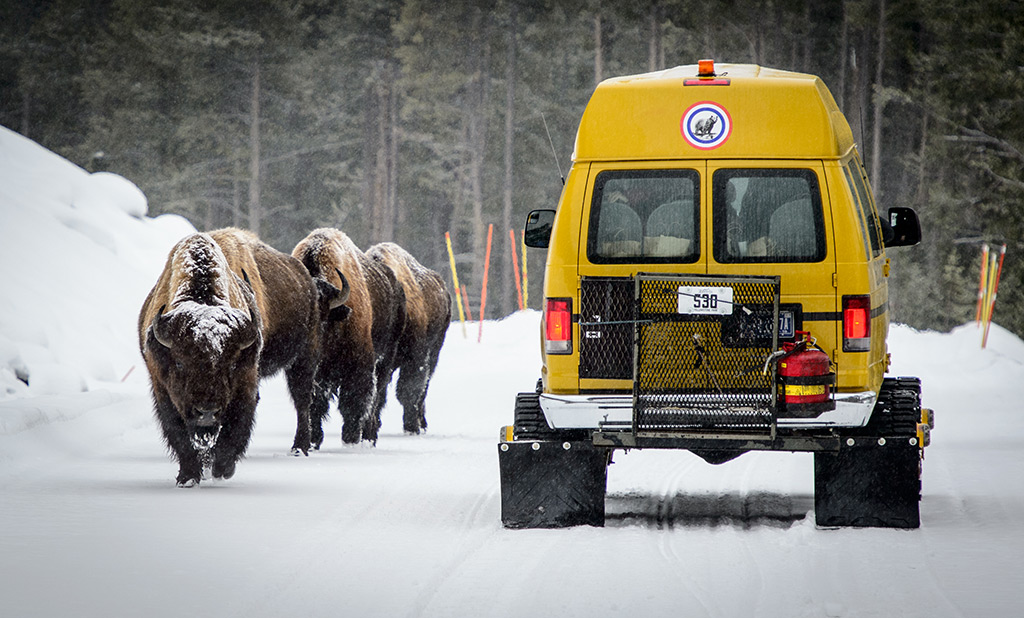By Scott Steen
Last year, as I rode with a group through a blizzard deep in the heart of Yellowstone National Park in an ancient Bombardier, we were completely surrounded by a herd of bison using the road to navigate the snowstorm. The day before, we had a “three dog day” — with multiple sightings of wolves, foxes and coyotes. The next evening, we drove out far into the black night to see a sky alive with countless stars and distant galaxies. And it occurred to me — as I am sure it has to millions of people before me — “Where else, except for a national park, would this be possible?”
I had a similar experience this summer during a rainy hike up a small mountain in Denali National Park. When we got to the top, the rain cleared briefly and dramatically, revealing endless miles of rolling tundra, without a sign of civilization in view.
As the year-long centennial celebration of the National Park Service winds down, I thought it appropriate to recognize what is, unquestionably, one of the most important achievements in our nation’s history and in the conservation movement. American Forests (then American Forestry Association) was founded just three years after Yellowstone became our first national park in 1872, and our history parallels, and has been shaped by, the creation of what historian Wallace Stegner called “our best idea.”
Our national parks are a roll call of superlatives. The tallest tree in the world, the Hyperion, is in Redwood National Park. The largest single stem tree in the world, the General Sherman, is in Sequoia National Park. The highest and lowest points in North America are in national parks (Denali and Death Valley, respectively). The longest cave system in the world is at Mammoth Cave National Park in Kentucky. The largest national park, Wrangell-St. Elias in Alaska, is bigger than Switzerland. The deepest lake in the U.S. is Crater Lake, in Crater Lake National Park (at 1,932 feet deep, it is 156 feet deeper than One World Trade Center, America’s tallest building, is tall). The list of miracles contained in the parks goes on and on.
But, the real thing that makes these parks so special is the transformative effect they have on people. I asked American Forests team members about their experience with the parks, and their stories speak to the ability of nature to inspire us, to bring us together and to expand our worldviews.
Family was an important theme. For example, one of our team members talked about how a trip at age four to Great Smoky Mountains National Park became her first vivid memory, combining the beauty of the fall foliage with the sounds of forest streams and a feeling of deep peace and love from being with her family. Another recounted how a visit to Denali National Park with his mother after graduation changed the direction of his life, and how he later brought his own children there to experience the sense of awe that he had once felt. A third talked about how a week-long camping trip in Sequoia National Park transformed his relationship with his children, bringing the family closer together than ever before.
Another theme was how the parks provide one-of-a kind, life changing experiences. Our vice president of conservation programs recounts how he and companions trekked more than 20 miles into an area southeast of Yellowstone Lake that is reported to be the farthest you can get from a road in the lower 48 states. As they approached the campsite, they happened upon a herd of elk drinking from the lake in the late afternoon sun. That evening, they heard wolves howling — the delta pack — known to use the area but rarely seen. Magic.
Our most devoted park aficionado, who has visited more than 100 national parks, monuments and historic sites so far, said his most amazing experience came after spending a month at Katmai National Park watching the bears feast on the annual salmon run. From there, he was able to catch a ride with a bush pilot to visit Aniakchak National Monument, one of the wildest and least visited parks in the National Park System. During his time there, he was only one of 11 visitors in the vast 601,294-acre park.
There are 59 national parks and 82 national monuments, plus hundreds more national historic parks, national historic sites, national preserves, national seashores and other holdings in the National Park System. They are in every state and territory and encompass a huge array of passions and interests. If you have never taken advantage of these national treasures, I urge you to get out there and explore. They may just change your life.
